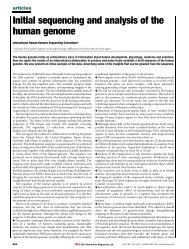2006. évi 1. szám - Jura - Pécsi Tudományegyetem
2006. évi 1. szám - Jura - Pécsi Tudományegyetem
2006. évi 1. szám - Jura - Pécsi Tudományegyetem
You also want an ePaper? Increase the reach of your titles
YUMPU automatically turns print PDFs into web optimized ePapers that Google loves.
Kitti Maros: Research on peyotism from a legal anthropological aspect<br />
73<br />
Kitti Maros<br />
PhD student<br />
Research on peyotism from a<br />
legal anthropological<br />
aspect<br />
I. Abstract<br />
While carrying out researches on legal cultures, I<br />
have always strived for choosing interesting fields.<br />
As a result of this, my field of interest has turned<br />
to the cultures of the Far-East, to Japan, China and<br />
India, whose charm is embedded in their exoticism:<br />
extraordinary people, customs, religions, the magic,<br />
different law systems and languages.<br />
In the past year I came across the psycho-anthropological<br />
works of an outstanding American<br />
researcher, Joseph D. Calabrese, and a field that is<br />
rather undiscovered within the boundaries of the<br />
Hungarian jurisprudence. Thus the idea of unifying<br />
the religious practice of peyote ingestion of the Native<br />
American Indians and Legal Anthropology was<br />
formed, and moreover, as the fruit of my research,<br />
this publication was carried out.<br />
First I want to point out the importance of the<br />
investigations of the legal anthropologists: the resarch<br />
on the problems of the etnic and the religious<br />
minorities is significant from a legal standpoint, as<br />
legal anthropology enlightens the social aspects of<br />
various defects of legal practice.<br />
In the second part of my paper I would like to<br />
carry out a research on the ritual use of peyote, a<br />
hallucinogenic drug employed by the members of<br />
the Native American Church. This subject has been<br />
discussed (and misunderstood) by several famous<br />
scholars. My intention is to prove my hypothesis,<br />
namely that none of these works have taken into<br />
serious consideration the fact that the approach towards<br />
ceremonial peyote custom must contain the<br />
world conception of the homo religiosi, therefore<br />
their conclusions remain void in regard of imparting<br />
a connotative synopsis of the phenomenon and<br />
misinterpret the therapeutic efficacy of the rite. The<br />
most general goal of the ceremonies is therapeutic<br />
by symbolically depicting the human life-span and<br />
embodying this depiction in a symbolic context (the<br />
changing of the moon and the dawning of the new<br />
day). The potential therapeutic efficacy manifests in<br />
the omniscience and omnipresence of the peyote that<br />
functions outside the rituals, aiding the adherents<br />
to resist excessive drinking. I think that the work<br />
of Joseph Calabrese reflects on possibly the most<br />
important characteristic features of the ritual peyote<br />
use: imparting the decoding of its symbolic structure<br />
enlightens a possible way of healing alcohol addicts<br />
in the battle against excessive drinking.<br />
<strong>1.</strong> A New Scientific Field:<br />
Legal Anthropology<br />
When setting forth the research, two questions<br />
arose. The first one was what Legal Anthropology<br />
is, since this discipline was rather unknown to me;<br />
never before had I met it during the course of my<br />
university studies and PhD years. And being a Hungarian<br />
jurisprudent, it had set me to think whether<br />
Hungarian legal anthropology exist. My concerns<br />
were answered in “The Main Currents of Legal Anthropology”<br />
by H. Szilágyi, István.<br />
2. What Is Legal Anthropology<br />
John Griffiths explains it as “the research of sociological<br />
phenomena in different cultures or societies<br />
primarily with the aid of comparative and microsociological<br />
methods”.<br />
As scholars agree upon the definition, the objective<br />
of Legal Anthropology lies between the scope of<br />
anthropology and jurisprudence. It is an interdisciplinary<br />
field: concerning methodological issues, it adopts<br />
the methods of anthropology, whereas regarding the<br />
objective, it is closer to jurisprudence. In order to understand<br />
this discipline, it is inevitable mention – as a<br />
science within the framework of cultural anthropology<br />
– ethnology that incorporates the comparison of different<br />
nations based on material culture, religion and<br />
social institutions. The three major differences between<br />
anthropology and ethnology are the following: (1) the<br />
anthropologist are evolutionists stating that societies<br />
follow the same path of evolution, while ethnologists<br />
claim the migration of cultures; (2) the anthropological<br />
methods are of comparative nature whereas the<br />
ethnological procedures are more descriptive; (3) the<br />
anthropological field of research concentrates chiefly<br />
on primitive cultures; the ethnologist focus on existing<br />
traditional cultures outside of Europe. However, from<br />
the beginning of the 1950’s, the anthropologists scope<br />
of research also incorporates the study of modern cultures,<br />
therefore the clear differentiation between these<br />
disciplines diminished to the extent that their terms of<br />
research methods – “ethnological research” and “field<br />
work” – are synonyms nowadays.<br />
In Anglo-Saxon territory, the juridical anthropology<br />
was a part of social anthropology at the turn of<br />
JURA 2006/<strong>1.</strong>
















